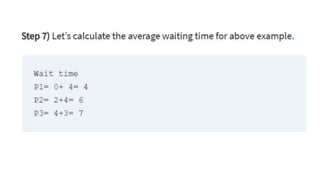Round Robin Algorithm.pptx
- 1. Round Robin Algorithm NAME: SANAD BHOWMIK ID:193-15-2952 SECTION: PC-A
- 2. What is Round Robin Algorithm? Round Robin scheduling algorithm is mainly designed for time-sharing systems. This algorithm is similar to FCFS scheduling, but in Round Robin(RR) scheduling, preemption is added which enables the system to switch between processes.
- 3. Characteristics of Round Robin Scheduling • A preemptive scheduling algorithm. • CPU shifts to the next process after a fixed time interval known as time quantum or time-slice. • Preempted processes are added to the end of the queue. • A hybrid and clock-driven model. • Time slice is usually the minimum but differs from OS to OS. • A real time algorithm that responds to an event within a specific time limit. • Oldest, fairest, and easiest algorithm. • Widely used in traditional OS.
- 4. Example of round robin algorithm
- 11. Advantage of Round-robin Scheduling •It doesn’t face the issues of starvation or convoy effect. •All the jobs get a fair allocation of CPU. •It deals with all process without any priority •If you know the total number of processes on the run queue, then you can also assume the worst-case response time for the same process. •This scheduling method does not depend upon burst time. That’s why it is easily implementable on the system. •Once a process is executed for a specific set of the period, the process is preempted, and another process executes for that given time period. •Allows OS to use the Context switching method to save states of preempted processes. •It gives the best performance in terms of average response time.
- 12. Disadvantages of Round-robin Scheduling •If slicing time of OS is low, the processor output will be reduced. •This method spends more time on context switching •Its performance heavily depends on time quantum. •Priorities cannot be set for the processes. •Round-robin scheduling doesn’t give special priority to more important tasks. •Decreases comprehension •Lower time quantum results in higher the context switching overhead in the system. •Finding a correct time quantum is a quite difficult task in this system.
- 13. Worst Case Latency •dt = Denote detection time when a task is brought into the list •st = Denote switching time from one task to another •et = Denote task execution time
- 14. Thank you
Editor's Notes
- (These don’t have designer IDs since they were based off the default master slides already in the deck.














